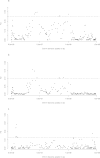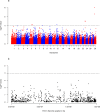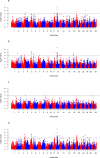Signatures of positive selection in East African Shorthorn Zebu: A genome-wide single nucleotide polymorphism analysis
- PMID: 26130263
- PMCID: PMC4486961
- DOI: 10.1038/srep11729
Signatures of positive selection in East African Shorthorn Zebu: A genome-wide single nucleotide polymorphism analysis
Abstract
The small East African Shorthorn Zebu (EASZ) is the main indigenous cattle across East Africa. A recent genome wide SNP analysis revealed an ancient stable African taurine x Asian zebu admixture. Here, we assess the presence of candidate signatures of positive selection in their genome, with the aim to provide qualitative insights about the corresponding selective pressures. Four hundred and twenty-five EASZ and four reference populations (Holstein-Friesian, Jersey, N'Dama and Nellore) were analysed using 46,171 SNPs covering all autosomes and the X chromosome. Following FST and two extended haplotype homozygosity-based (iHS and Rsb) analyses 24 candidate genome regions within 14 autosomes and the X chromosome were revealed, in which 18 and 4 were previously identified in tropical-adapted and commercial breeds, respectively. These regions overlap with 340 bovine QTL. They include 409 annotated genes, in which 37 were considered as candidates. These genes are involved in various biological pathways (e.g. immunity, reproduction, development and heat tolerance). Our results support that different selection pressures (e.g. environmental constraints, human selection, genome admixture constrains) have shaped the genome of EASZ. We argue that these candidate regions represent genome landmarks to be maintained in breeding programs aiming to improve sustainable livestock productivity in the tropics.
Figures




References
-
- Hanotte O. et al. African pastoralism: genetic imprints of origins and migrations. Science 296, 336–339 (2002). - PubMed
-
- Chen S. et al. Zebu cattle are an exclusive legacy of the South Asia neolithic. Mol. Biol. Evol. 27, 1–6 (2010). - PubMed
-
- Troy C. S. et al. Genetic evidence for Near-Eastern origins of European cattle. Nature 410, 1088–1091 (2001). - PubMed
-
- Gifford-Gonzalez D. & Hanotte O. Domesticating Animals in Africa: Implications of Genetic and Archaeological Findings. Journal of World Prehistory 24, 1–23 (2011).
Publication types
MeSH terms
Grants and funding
LinkOut - more resources
Full Text Sources
Other Literature Sources
Miscellaneous

